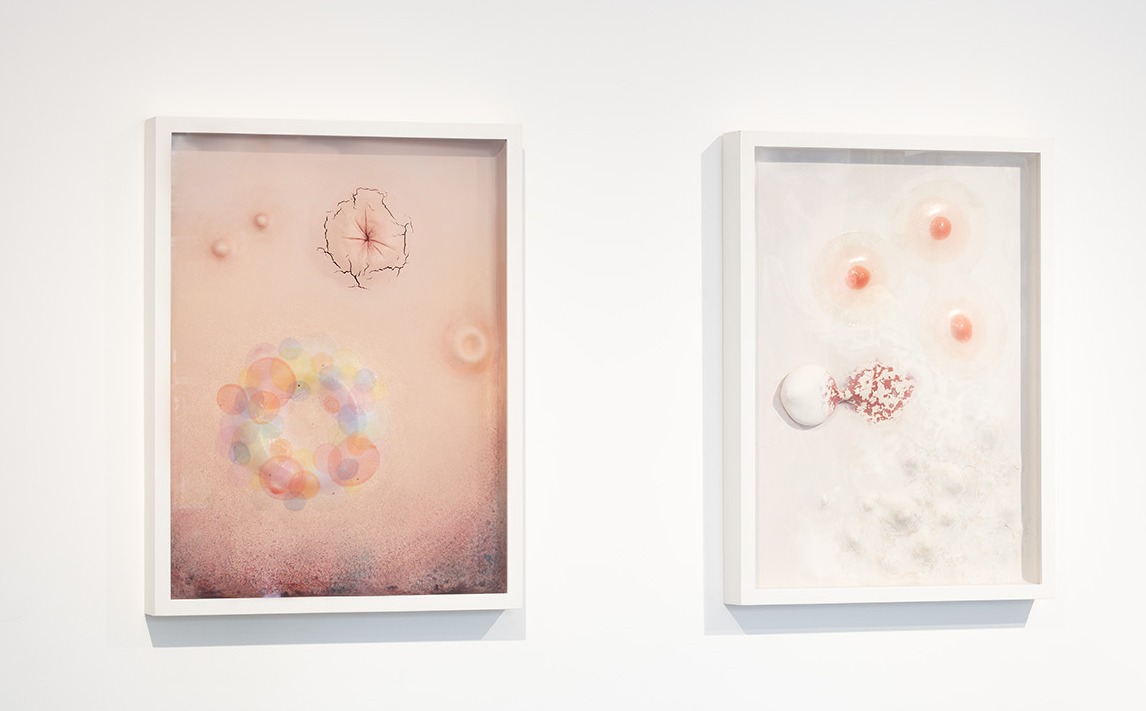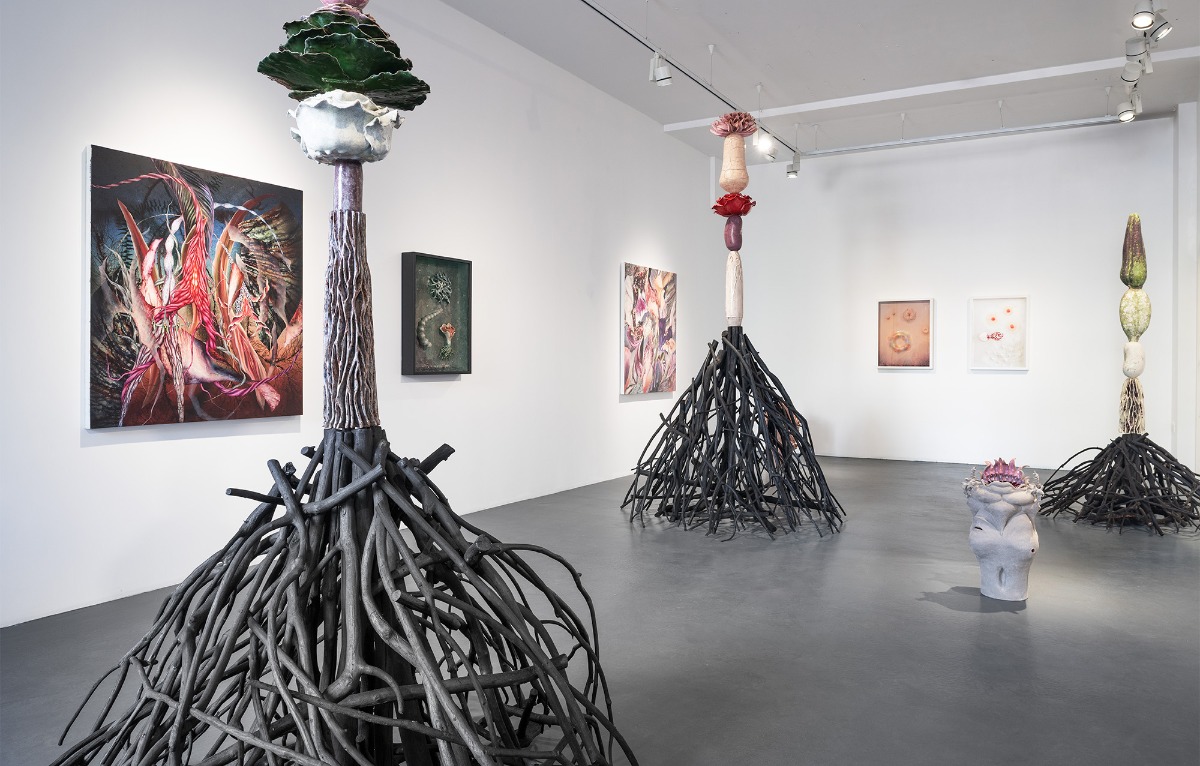
Giving space to rare things
A conversation with Polish artist Paweł Matyszewski on queerness and love of plants in art
Paweł Matyszewski (1984) is a Polish artist and gardener. His exhibition Momentary Organisms held at Kogo Gallery in Tartu, Estonia, curated by Šelda Puķīte, is the artist’s first solo show in the Baltic States. Paweł’s paintings, objects and sculptures explore hybridity in its diverse forms. In a bold post-anthropocentric manner, the artist fuses species, genres and media. While his depictions of plants oscillate between portrait and landscape, his uncanny figurations of human skin enrich visual art with a tactile element, as observed by the Polish art historian Marta Smolinska. In his fusions and imaginary crossbreedings of plants and humans, the artist seems to give preference to the former. Having lately turned to the medium of sculpture, Matyszewski has produced works that speak to the most urgent political and ecological challenges of our time. In the conversation we sought to put the current exhibition within a broader context of Paweł’s transforming artistic practice.
View from a solo exhibition Momentary Organisms by Paweł Matyszewski, 2025, Kogo Gallery. Photo: Marje Eelma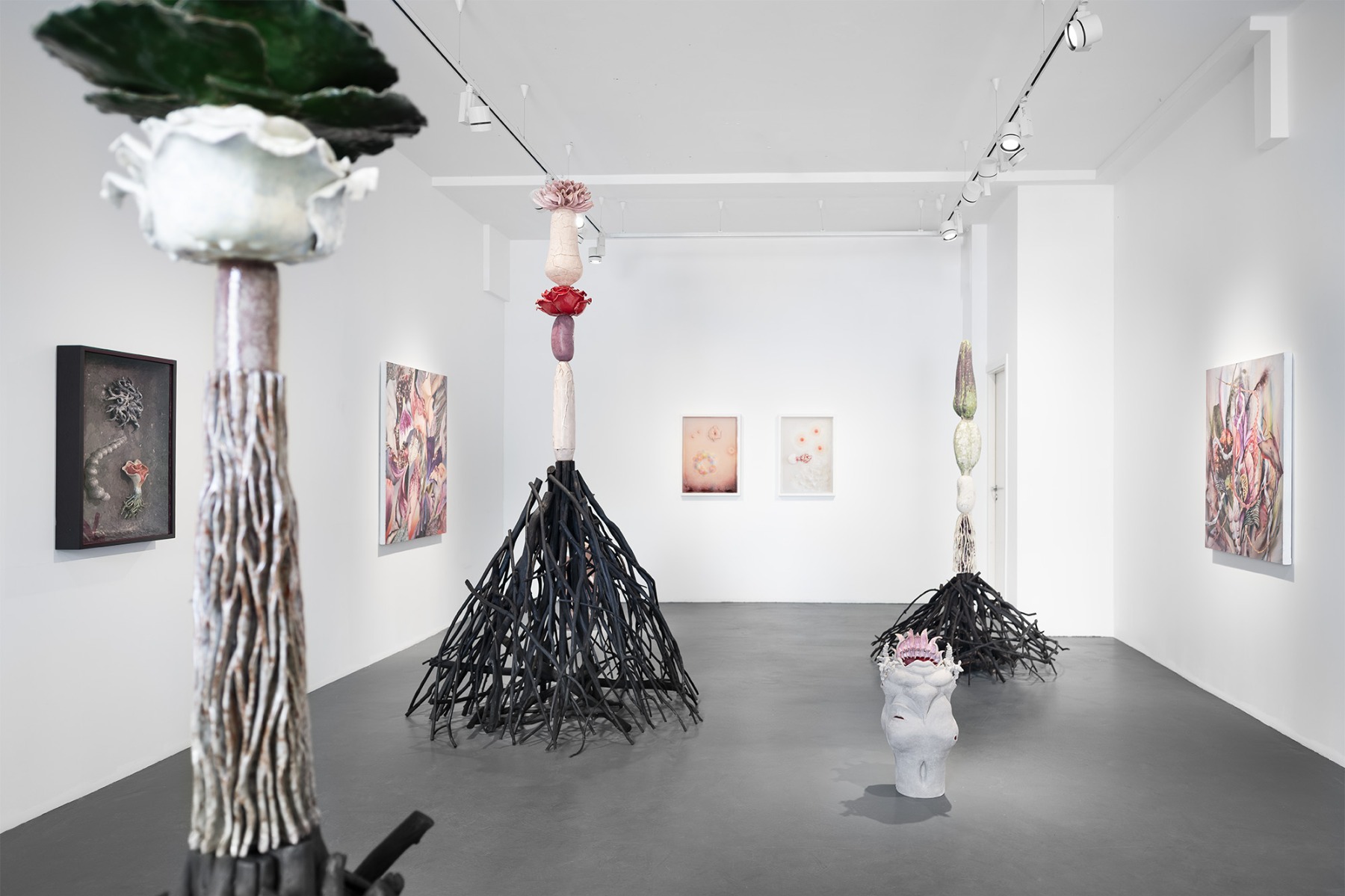
Momentary Organisms is part of the series Thrifters and Transformers animated by the idea of meaningfully transforming existing practices into new matter. The exhibition presents a selection of paintings alongside sculptural works that mark a new direction in your practice. How did this transformation occur?
Initially my medium was acrylic painting. Then I started to also add oil painting, because some of the details of my artwork work better in acrylic or oil. Being part of the queer community, I used to do art responding to the complicated situation of queers in Poland at that moment. After having moved from the city to the countryside, where my closest neighbour lives about 1 km away, new subjects and objects in my art relate to the changing rhythm of nature. I have a huge garden, and I take stuff from there, like flower petals that you can see in my painting cycle Patches. Sometimes they are fresh, sometimes almost dying, like compost.
Your Patches fuse the splendid beauty of flowers with an uncanny dint of decomposition. Does your attachment to plants stem from aesthetic appreciation or is it also due to ecological concerns?
At first glance, most of my works can be seen as visually attractive. But once you discover the small moments, you see that it can be cruel. Over the years, my view of the plants has changed – if in the beginning I was drawn by their beauty and treated them as a miracle of our world, now I’m more focused on the simple things like plant seeds that most people don’t even notice, or like the plants that are dying. With massive deforestation and land clearing humans are waging a war on nature that the plants cannot win.
Paweł Matyszewski, Momentary Organism 3, 2024–2025. Ceramics, chalk, pigments, wood, metal construction, 260 × 140 × 140 cm. View from a solo exhibition Momentary Organisms by Paweł Matyszewski, 2025, Kogo Gallery. Photo: Marje Eelma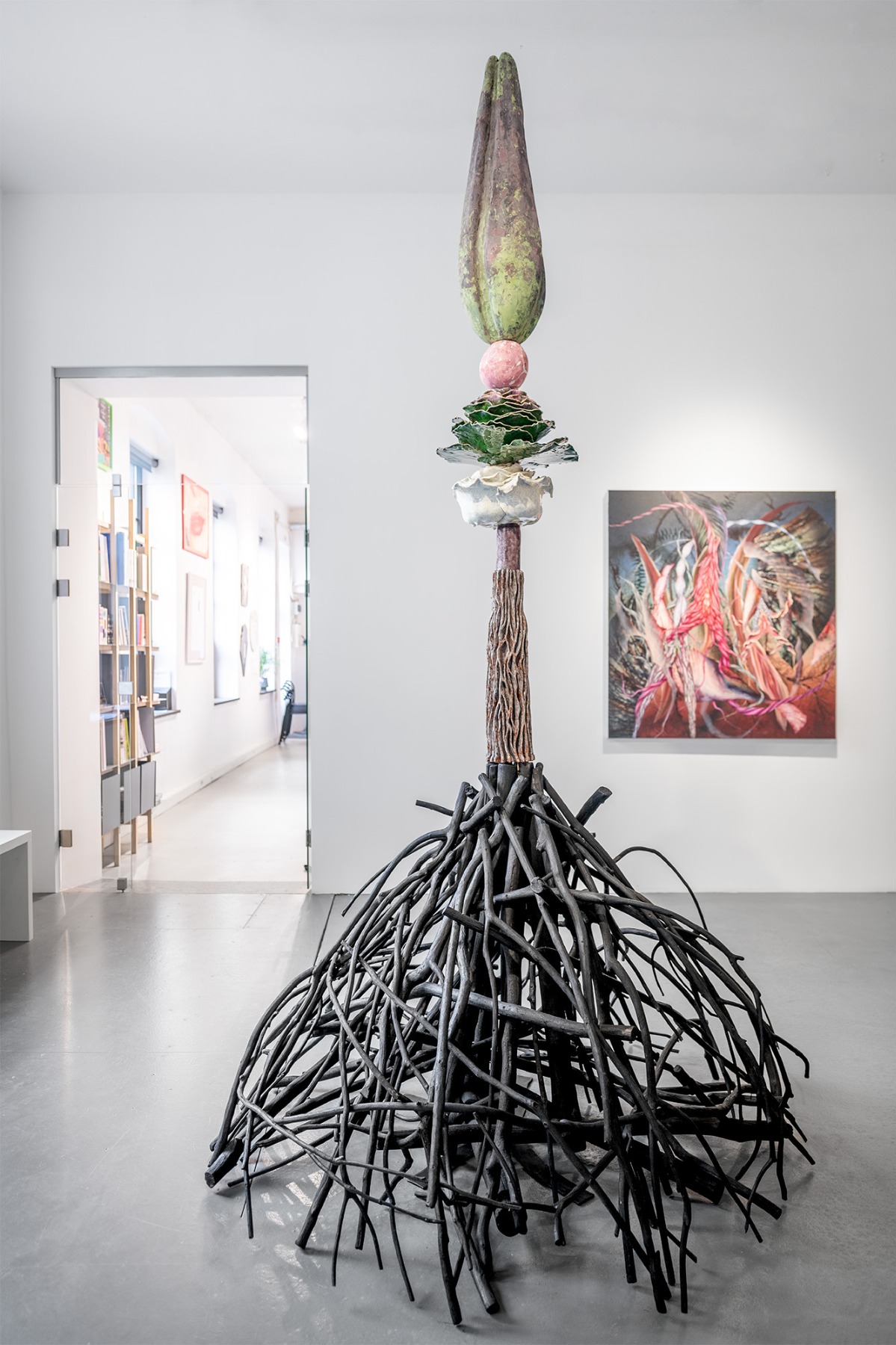
From what I know you’re experimenting with plant hybridization. How does this interest in hybrids translate into your practice?
Yes, I try to grow actual hybrid plants, but it is quite difficult, so I’m still in progress. Obviously, in my art I don’t have such constraints. For instance, the Biological Composition paintings featured in the exhibition present post-apocalyptic landscapes with new hybrid species growing out of human skin when the humans are no longer around.
Your new ceramic works seem to take hybridization even further, embodying hybrids of nature and culture.
Yes, my two Fusion sculptures portray the emergence of new hybrid organisms in the shape of a cultural artefact – a vase. The glazed inside of the vase creates the impression of living matter, as if you were looking inside an organism that could be an animal or a carnivorous plant, or both at the same time. Some people saw in these works a sculptural translation of my Biological Composition paintings. Not exactly, but there is some bridge between them.
Paweł Matyszewski, Collection 12, 2018. Mixed media, 72 × 56 × 5 cm. View from a solo exhibition Momentary Organisms by Paweł Matyszewski, 2025, Kogo Gallery. Photo: Marje Eelma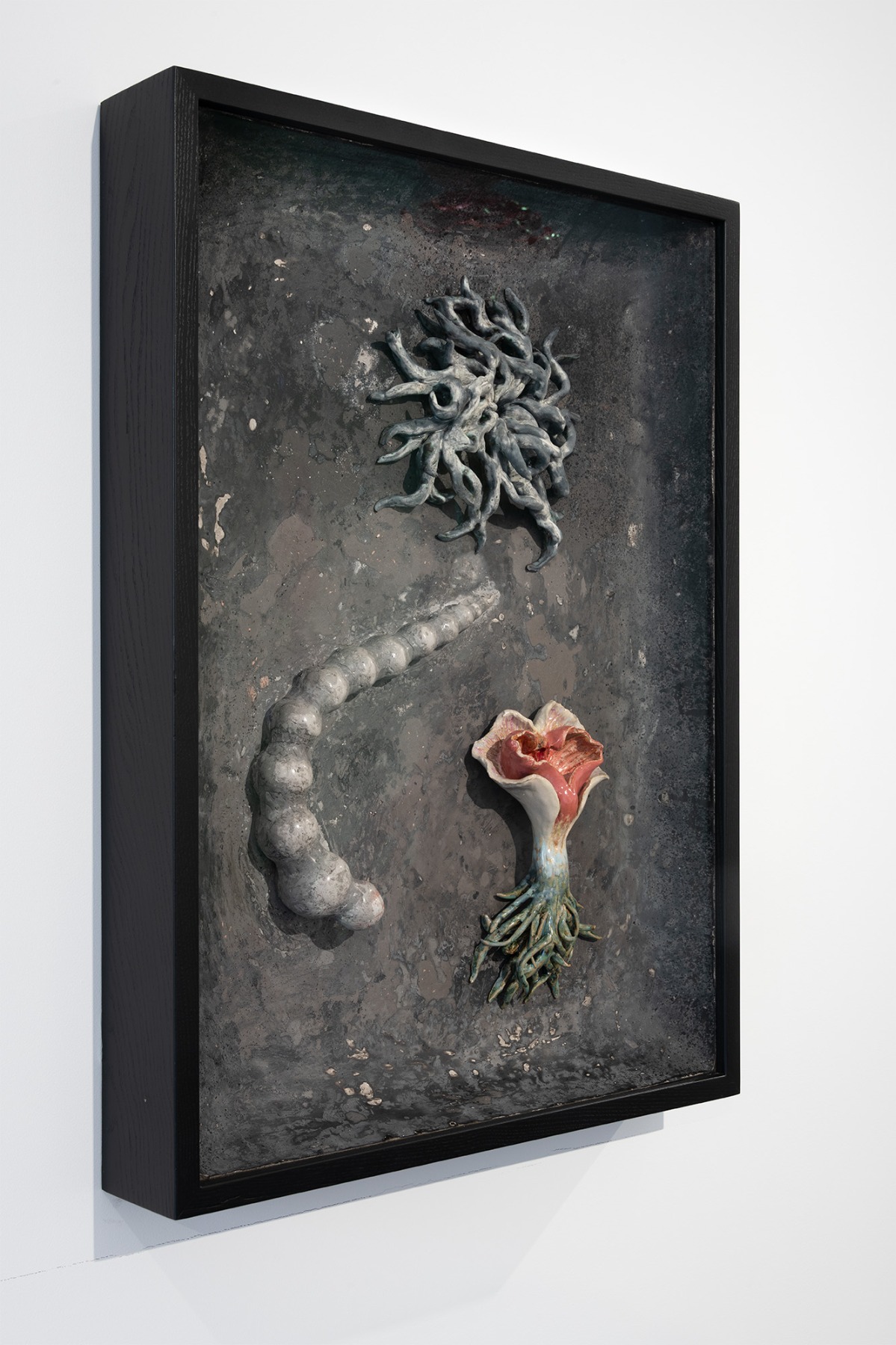
The title Momentary Organisms derives from a series of three other new pieces forming the center of the exhibition – mixed media portable plant-like sculptures with exposed roots that curator Šelda Puķīte describes as trees that have been torn out of the ground and totems that hold the sacred fruits of life for those in need. The principle of fusion employed in your organic vases here gives way to modular combination of separate elements, some of which resemble cultural artefacts like projectiles. How did you develop this approach and in what sense are these assemblages momentary?
I live near the Belarusian border, so when I go to art residencies people from countries like Germany tell me “Oh my gosh, so you live near the Belarusian border! Aren’t you afraid about your future, about your place?” So I started to think about my place, my village, my garden, our home that I would have to leave if there were an invasion. And I wanted to create an artwork that would speak about our roots, the places where we were born. Of course, we can change our life, we can move somewhere else and we can have a home there. But in my case, I’m really connected to my land, my family. I chose to come back here after graduating the University of Arts in Poznań. It’s the Western part of Poland, quite far away from here.
I was also thinking about the refugees on the Belarusian border who have left their country and home. In such cases, one can take members of their family, one can take animals, maybe some books or photos or other small things, but one can’t take the gardens, plants and orchards. I spoke to people who had to leave their place when the state borders were redrawn during World War II. So I wanted to create trees that we could take to another place and that would also function as food banks with vegetables and edible flower buds. I like the weird way these different things are connected in one piece.
View from a solo exhibition Momentary Organisms by Paweł Matyszewski, 2025, Kogo Gallery. Photo: Marje Eelma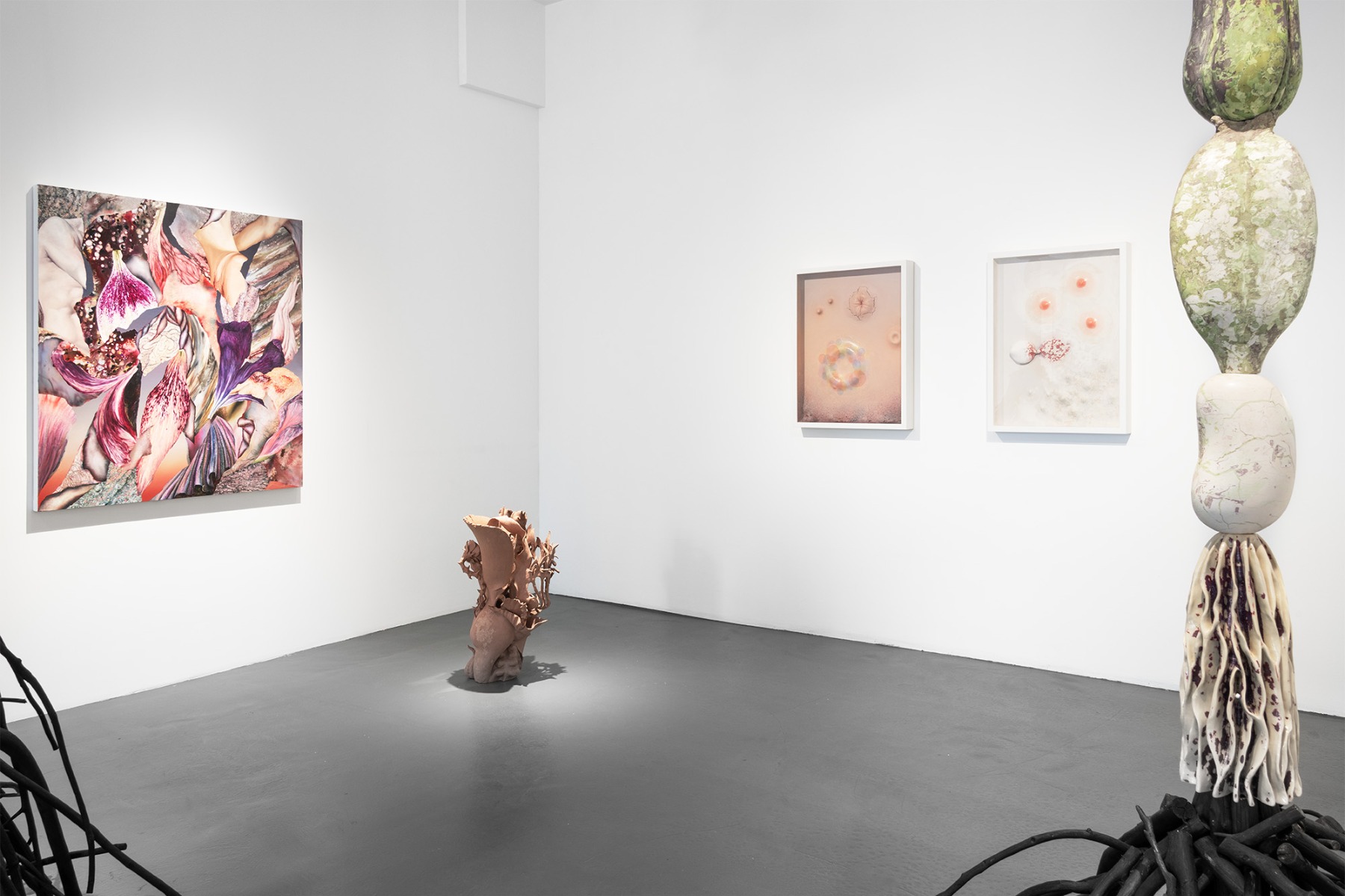
Can we say that the idea of a catastrophe, past or future, unites the different works of the exhibition?
Yeah, we can. Somehow, for most of my life I have been assuming that the worst-case scenario will play out. At the same time, I could never foresee the tough times the whole world is going through. But I think that not only my sculptures, but also some of the paintings evoke a disaster that has led to fragmentation. The patches in my works can be interpreted as small bits of life, emerging out of post-apocalyptic decay.
Would you describe the motifs of fusion, hybridity, patchworking in your work as part of a queer aesthetic? I’m thinking of it as part of a broader queer ecology that would be critical of the traditional straight and binary view of nature.
Yes, we can say that because in my work the borders are very fluid. In some pieces, you can see female or male or intersex body parts really close to each other, so that you can’t tell if it’s one body or different bodies within a larger organism. I have also explored body modification and the issue of sexual abuse.
Photo: Marje Eelma
To my philosophical ear, your approach to the body resonates with the concept of body without organs as employed by Deleuze and Guattari, or with Slajov Žižek’s proposed counterconcept of organs without bodies. As contrary as they are, both signal the breakdown of the organism as a stable, fully structured whole. If we keep in mind the etymology of the word ‘organ’ deriving from organon, the Greek word for ‘tool’, I would say that in you Fusion works, for instance, the normal function of the mouth or the vagina gets suspended. The same can be said about the anus-like shape in Collection 8 and other works of your pictorial dermatology, to use the Marta Smolinska’s concept.
Definitely, I think that they have lost their previous function and turned into the remains of the body. I think that the plant organisms are even more important in this case. In Fusion 1, for example, the mouth that you mentioned cannot speak because it’s no longer “in charge” of this organism. I would say that these elements of the human body have lost their usual place and meaning, have become a kind of compost for something alien, likely born out of a catastrophic event. Human vagina, penis, brests are sometimes poetically referred to as the flowers of the body. Just like flowers, these body parts are attractive because they are involved in the process of reproduction. I my works I stage a kind of struggle between them and actual flowers, and the latter seem to be winning.
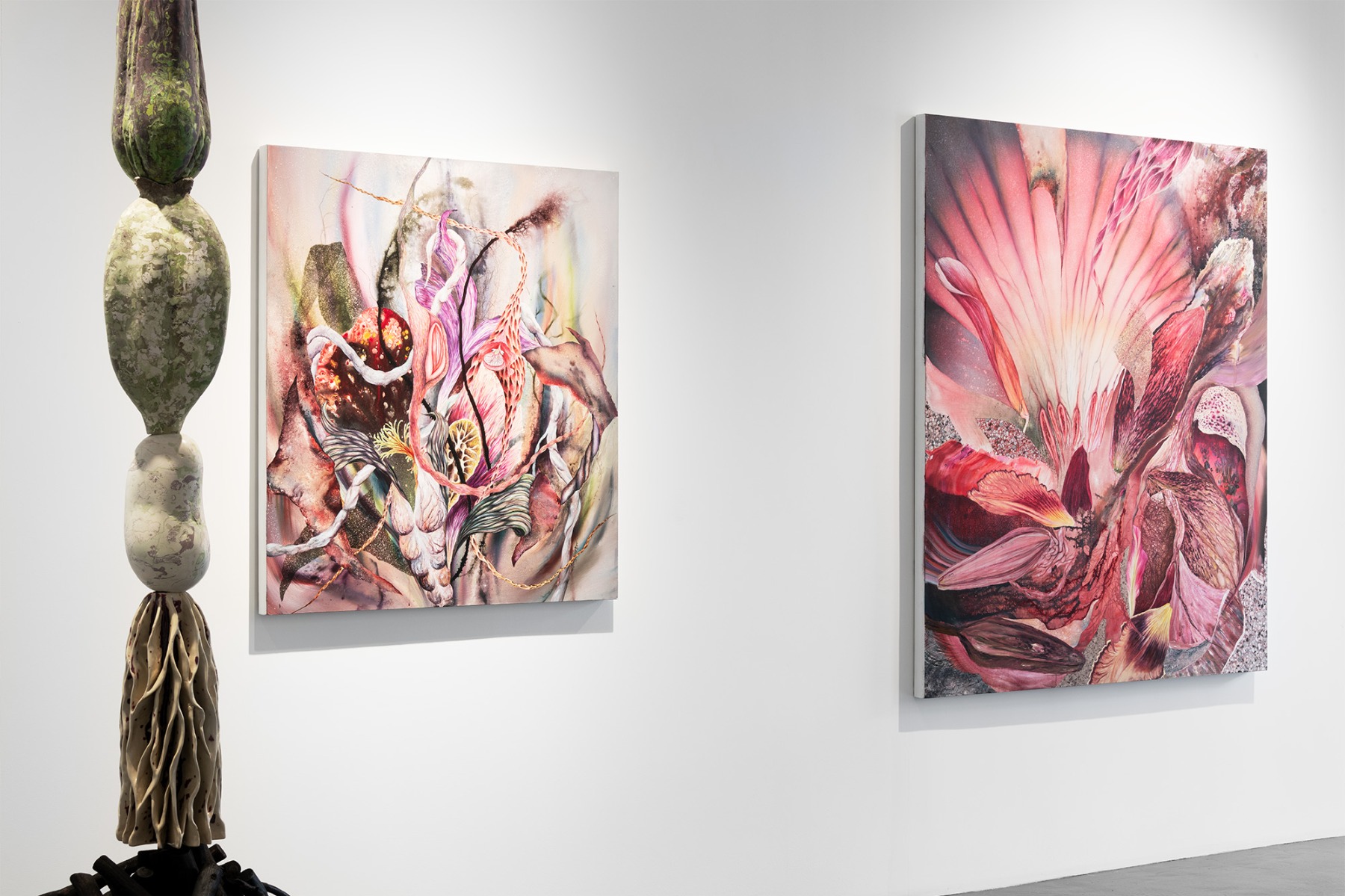
You’re speaking about attraction and desire in connection with reproduction. But, to return to the question of queer ecology, desire does not always limit itself to reproducing life. To me your art clearly spells out desire, and I’m wondering whose desire it could be. The ecosexuality movement promotes love and desire for plants as part of the natural world, but does it ask about what plants love and desire? Maybe we should speak of vegetal desire as we do of vegetal intelligence?
It is the desire of the plants as imagined by me. We know from current research that plants are very intelligent, they react to external stress, they have family life, they nurture their young and share resources among themselves. At the same time, I can only imagine what the desire of the plants is like. However, my art also speaks about humans. Momentary Organisms are not just about plants, they are also about our anxiety. I would like to combine these two worlds as much as possible, but I still see things from the human perspective.
Do you see any political takeaways from such combination? The way you employ fusion and patchworking seems to signal a critique of the “normal” worldview where everything has its proper place.
My art is closely connected with what is rare – rare species, rare things. At the beginning, it was my sexuality and the queer community. Now it has more to do with the environment. I like giving space to rare things – because I feel that I’m one myself. And it’s important to show to the rest of the world that we exist.
Photo: Marje Eelma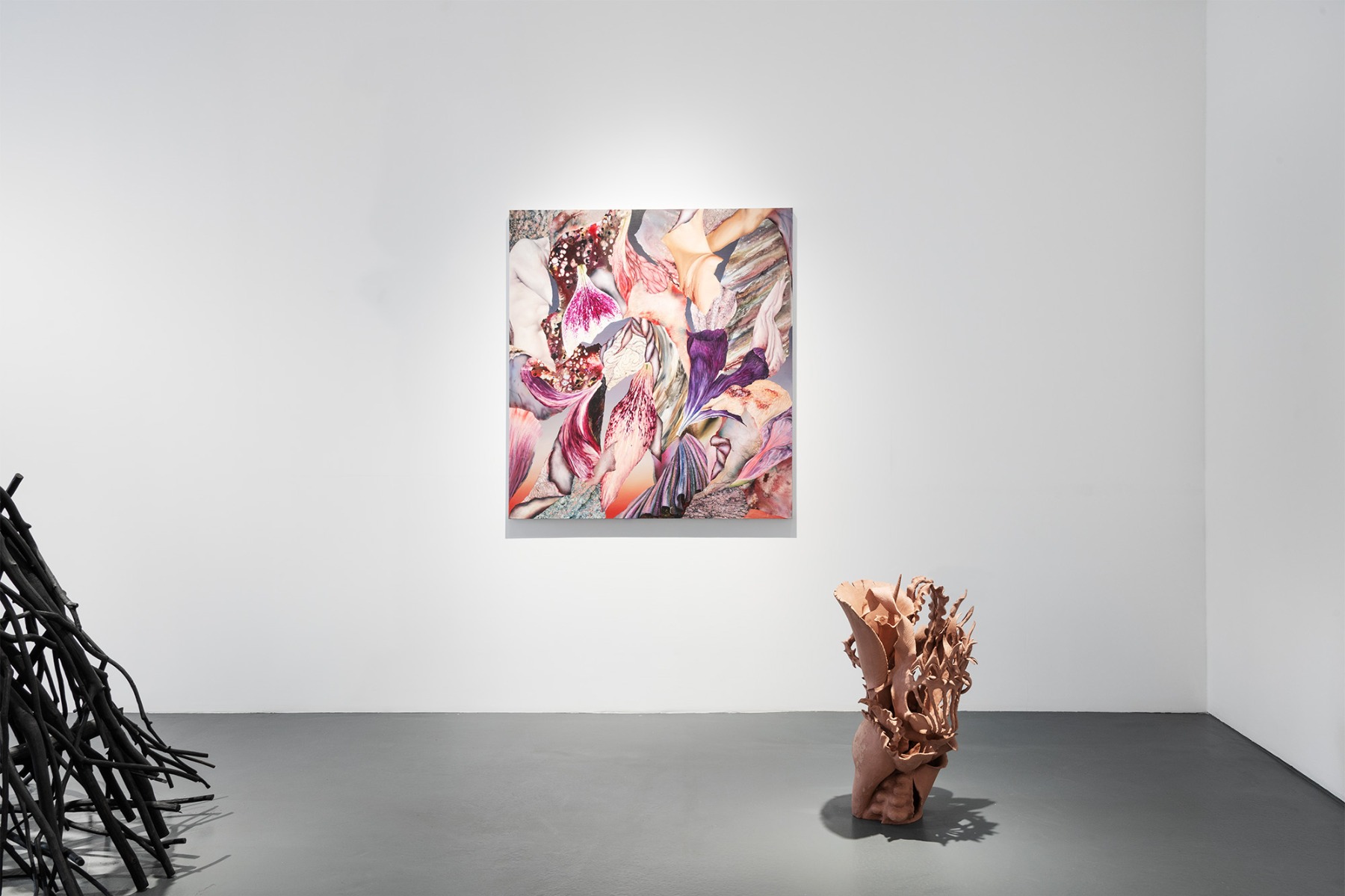
Where in the world are you planning to exhibit your upcoming work?
Momentary Organisms will be exhibited in Poznań in November at a group show about plants. And there will be new sculptures featuring enlarged seeds from my garden. Plants that most people consider useless weeds will become the heroes in these works. I was also invited to create a sight-specific public sculpture in a park in Serbia. I’m thinking of making a compost sculpture that will become home for mushrooms and insects. I will also have two solo exhibitions early next year in Poznań and Bielsko-Biała. The funny thing is that I’m mostly invited to do my shows in spring, like a seasonal artist. More and more often curators invite me to exhibit my work outdoors. And there is proposition in Barcelona for the end of the next year. So we will see how it works.
Sounds busy. I hope to see more of your art in the Baltic States too. Good luck and thanks for your time!
